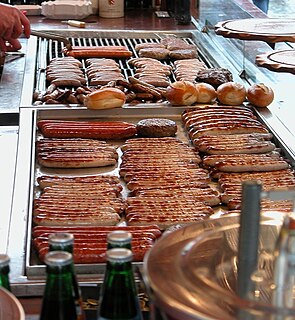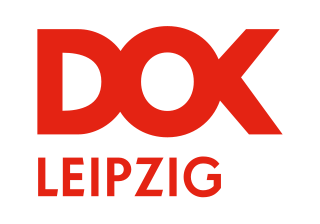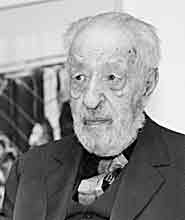 W
WAmpelmännchen is the symbol shown on pedestrian signals in Germany. Prior to German reunification in 1990, the two German states had different forms for the Ampelmännchen, with a generic human figure in West Germany, and a generally "male" figure wearing a hat in the East.
 W
WThe cuisine of Germany is made up of many different local or regional cuisines, reflecting the country's federal history. Germany itself is part of a larger cultural region, Central Europe, sharing many traditions with neighbouring countries such as Poland and the Czech Republic. Southern regions, like Bavaria and Swabia, share dishes with Austrian and parts of Swiss cuisine.
 W
WThe Cultural Association of the GDR was a federation of local clubs in the German Democratic Republic (GDR). It formed part of the Socialist Unity Party-led National Front, and sent representatives to the Volkskammer. The association had numerous writers as its member, including Willi Bredel, Fritz Erpenbeck, Bernhard Kellermann, Victor Klemperer, Anna Seghers, Bodo Uhse, Arnold Zweig. Its first chairman was Johannes Robert Becher.
 W
WThe culture of East Germany varied throughout the years due to the political and historical events that took place in the 20th century, especially as a result of Nazism and Communism. A reflection on the history of arts and culture in East Germany reveals complex relationships between artists and the state, between oppositional and conformist art. In four decades, East Germany developed a distinct culture and produced works of literature, film, visual arts, music, and theatre of international acclaim. Popular culture specialities included among others a high popularity of nudism in Eastern Germany.
 W
WDOK Leipzig is a documentary film festival that takes place every year in Leipzig, Germany. It is an international film festival for documentary and animated film founded in 1955 under the name "1st All-German Leipzig Festival of Cultural and Documentary Films" and was the first independent film festival in East Germany. In 1995 a separate competition for animated films was added and in 2004 a film industry program, DOK Industry, was initiated to allow a networking and contact platform for industry professionals. Shortly after German reunification attendance figures dropped, with just 5,500 people coming in 1993; however, they quickly picked up and in 2008 the festival had more than 27,000 attendees. The 2010 International Leipzig Festival for Documentary and Animated Film ran from 18 until 24 October 2010. DOK Leipzig is part of the Doc Alliance – a creative partnership between 7 key European documentary film festivals.
 W
WEarly Bourgeois Revolution in Germany, also known as the Peasants' War Panorama (Bauernkriegspanorama), is a monumental painting by the East German painter Werner Tübke, executed from 1976 to 1987. It spans 14 metres (46 ft) by 123 metres (404 ft) and depicts a circular panorama of the Battle of Frankenhausen, fought on 15 May 1525 during the German Peasants' War. The painting has more than 3000 characters.
 W
WJugendweihe or Jugendfeier is a secular coming of age ceremony practised by German 14-year-olds. It originated among the secular societies in the 19th century as an alternative to Confirmation by the Roman Catholic and Protestant churches. It was especially widespread in East Germany, where state atheism was encouraged under the GDR.
 W
WKetwurst is a form of hot dog created in the German Democratic Republic. The word "Ketwurst" comes from a combination of Ketchup and Wurst.
 W
WThe Kino International is a film theater in Berlin, built from 1961 to 1963. It is located on Karl-Marx-Allee in former East Berlin. It hosted premieres of the DEFA film studios until the fall of the Berlin Wall in 1989. Today it is a protected historic building and one of the main venues of the annual Berlin Film Festival, the Berlinale.
 W
WJürgen Kuczynski was a German economist, journalist, and communist. He also provided intelligence to the Soviet Union during World War II.
 W
WThe Magischer Zirkel der Deutschen Demokratischen Republik was a national magicians' association that was active in East Germany from 1956 to 1969, and again briefly in 1990.
 W
WWerner Stötzer was a German Artist and Sculptor. For the last three decades of his life he lived and worked in Altlangsow in the marshy Oderbruch region of Brandenburg.
 W
WA string bag, net bag, or mesh bag is an open netted bag. Mesh bags are constructed from strands, yarns, or non-woven synthetic material into a net-like structure. String bags are used as reusable shopping bags and as packaging for produce.
 W
WIn culture of East Germany, Tal der Ahnungslosen was a sarcastic designation for two regions in the southeast and northeast parts of East Germany that generally were not able to receive TV broadcasts from West Germany from the mid-to-late 1950s, including the public broadcasters ARD and ZDF, to early 1990 just prior to German reunification.
 W
WWerte der deutschen Heimat originally Werte der Deutschen Heimat and, between 1970 and 1990 called Werte unserer Heimat, was a series of publications by former East German Academy of Sciences at Berlin, that was published by Akademie-Verlag Berlin and included more than 50 volumes. The work was undertaken by the Academy’s Local History Working Group within the Institute for Geography and Geo-ecology.